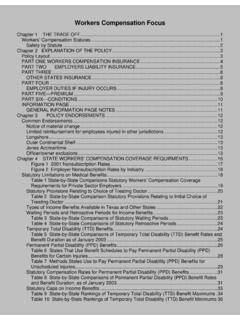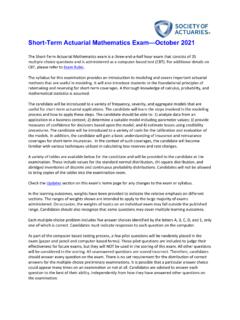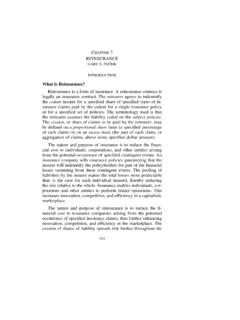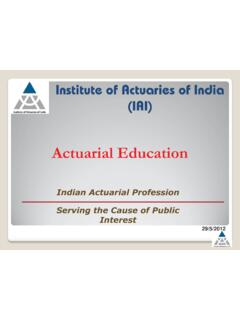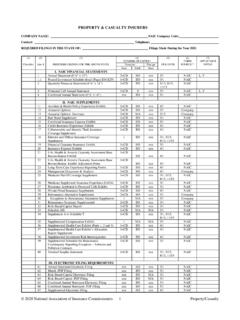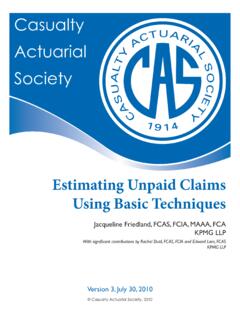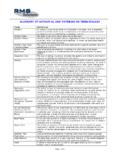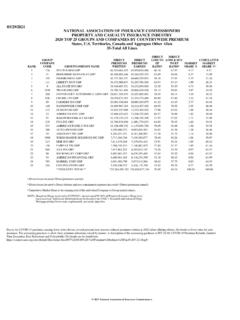Transcription of Underwriting Principles and Controls Part I
1 I Underwriting Principles and Controls Part I Table of Contents Chapter 1 Underwriting BACKGROUND AND OBJECTIVE 1 Underwriter s Goal 1 Underwriting Process 3 Historical Development of Underwriting 5 Traditional Underwriting Practices 5 Little Information Available 6 Rating Process Systematized 6 Underwriter Responsibilities 7 Potential for Conflict 8 Types of Underwriters 8 Line Underwriters 8 Providing Service to Producers and Policyholders 9 Staff Underwriters 9 Conducting Underwriting Audits 10 Evaluating Underwriting Experience 10 Formulating Underwriting Policy 11 Financial Capacity 11 Regulation 12 Personnel and Physical Resources 12 Reinsurance 12 Functions 12 Types of Reinsurance 13 Proportional and Non-Proportional Reinsurance 13 Proportional 14 Non-proportional 14 Risk Sharing 14 Retrocession 15 Broker vs.
2 Direct Reinsurance 16 Specialty Features of Reinsurance Contracts 16 Chapter 2 DEVELOPING Underwriting CRITERIA 17 Guideline Development 17 Underwriting Guideline Examples 17 21st Century Insurance Co. Commercial Auto Guidelines 17 Other Types of Underwriting Guides 24 Underwriting worksheet 24 Chapter 3 OVERVIEW OF LIFE/HEALTH Underwriting 26 The Underwriting Decision 27 Establishing Risk Classes 28 Underwriting Guidelines 29 The Numerical Rating System 29 The Underwriting Manual 29 Rating Manuals 30 Limitations of Underwriting Manuals 35 Deviation from Underwriting Guidelines 36 Immediate Decision 36 Experimental Underwriting 36 Chapter 4 Underwriting STEPS 39 ii Preliminary Processing 39
3 Information for Current Files 40 Case Assignment Systems 40 Underwriting the Case 41 Information Sources 41 Property casualty Underwriting Development 42 Producers 43 Applications 43 Inspection Reports 44 Government Records 44 Financial Rating Services 44 Loss Data 44 Claim Files 45 Underwriting , Pricing and the Actuary 46 Actuary and Reserving 47 Summary of actuarial Principles 52 Must Know Whereof They Speak 53 Chapter 5 PRICING INSURANCE PRODUCTS 53 Pricing Objectives 53 Adequate Rates 54 Ratemaking Responsibility 54 Ratemaking Process and Terms 55 Ratemaking Process 55 Ratemaking Illustration 55 Ratemaking Factors 56 Ratemaking Terms 57 Loss Reserves Estimation 57 Paid Losses 58 Reported But Not Paid Losses 59 Incurred But Not Reported (IBNR)
4 Losses 59 Investment Income 61 Other Factors 61 Chapter 6 RATEMAKING METHODS 61 Loss Adjustment Expense and Ultimate Loss 62 Provision for Expense and Profit 62 Table 7-1 62 Combining the Concepts 63 LAE and Ultimate Loss Estimates 64 Addressing Reserves 65 Estimate of losses 66 Cumulative Loss Development Estimates 67 Ultimate Losses Estimate 68 Apply Trending 69 Adjust Levels 69 Determining Auto and Homeowners Rates 69 Double Standard 70 Using Historic Cost 71 Loss Development Factors 72 Rate Analysis 72 Ratemaking Components 73 Mechanics of Class Rating 73 iii Pure Premium Ratemaking Method 73 Loss Ratio Ratemaking Method 75 Other Types of Rating 75 Life Insurance Ratemaking 77 Adoption of 2001 Mortality Table 77 NSP as Example Base 78 Table 6-1 79 Ratemaking Varies 82 Chapter 7 LEGAL ISSUES AFFECTING Underwriting 83 Title V of ADA 83 Title V Insurance Underwriting 84 Court Decisions 84 Functions and Impact of Underwriting and Risk Classification 85 Underwriter Binds the Insurer.
5 Waiver and Estoppel 85 Estoppel 85 Waiver 86 Used Interchangeably 86 Parol Evidence Rule 89 Underwriting Aspects Affecting Legal Position 90 Chapter 8 ECONOMICS OF Underwriting RISK 91 Adverse Selection 91 Concept of Risk and Return 91 Portfolio Theory and Underwriting 92 Goal of Underwriting 93 Determining Underwriting Margin 94 Getting Together the Buyers and Sellers 94 Missing Puzzle Piece 95 Frictional Costs 96 Risk Information Required 96 What You Don t 97 Benefit of Commissions 97 Graph 8-1 98 Enter the Intermediaries 99 The Agent or Producer is Market Maker 99 Going, 100 Accurate Information to Quantify Risk 101 Growth Rates and Underwriting Risks 102 Insurance: A Risk to the Economy?
6 102 The Economics of Insurance: Life's a Gamble 102 The Insurance Industry's Own Catastrophic Event 104 A Damper on the Economy? 105 1 Underwriting Principles and Controls Part I Chapter 1 Underwriting BACKGROUND AND OBJECTIVE Basically, Underwriting consists of two components; risk assessment and pricing. Successful Underwriting requires a system of risk selection to obtain a group in which loss results will be reasonably predictable by means of the law of averages. To accomplish this goal there must be a balance between obtaining volume and obtaining homogeneous risks.
7 If an insurance company issuing individual life policies, for instance, adopted such strict standards that it would only accept individuals who were practically perfect physically, ideal from a moral standpoint, and in risk-free occupations, there would be only a very small group from which to choose. Such a group would be very homogeneous, with all the risk units--in this case the individual lives--subject to about the same chance of loss. But the mass or volume of risk units would be very small, and thus the predictability of loss might be adversely affected.
8 Another element entering in to make selection of such a group impractical would be that selection procedures necessary to obtain this near-perfect set of individuals. The expense involved would more than offset the savings from the mortality rate of the group. In Underwriting , selection expense is a factor to be considered. There has to be a balance between the strictness of selection standards and the necessity of having a large volume of risk units to be insured. For example, group life insurance selection standards are set up to achieve this balance.
9 Usually group insurance companies adopt selection standards broad enough to permit acceptance of the large majority of insurable risks at standard premium rates. Certain groups employed in hazardous occupations will have mortality rates consistently higher than standard risks. They have to be classified as substandard risks and a policy covering them would have a higher premium rate. A risk may even be rejected entirely because the mortality rate is too great or too unpredictable for insurance to be practicable.
10 The chance of loss is never exactly the same for all risks or groups, even within the classification of insurable risks into the standard class and several substandard classes. In each class there are good risks and poor risks relative to the rest of the class. Underwriter s Goal It is the goal of the insurance underwriter to establish rules which will result in securing an average proportion of good risks. If the underwriter can accomplish this goal, the company's average mortality cost will be lower and the company may be able to offer insurance at a lower net cost.
